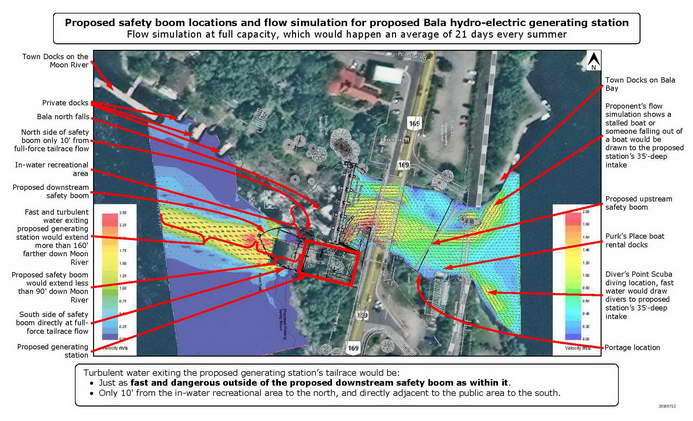Summary
The proposed project would not comply with the proponent’s environmental approval, as the water on all three sides outside of the downstream safety boom would be too dangerous for in-water recreation …
- Downstream, as water three times as fast as considered safe by Transport Canada would extend over 160′ outside of the proposed safety boom.
- To the north of the proposed safety boom, as this would allow those recreating at the base of the Bala north falls to be just ten feet from extremely dangerous water.
- To the south of the proposed safety boom, which would be directly at the extremely dangerous water as it would exit the proposed generating station’s tailrace.
Detail
- The MNR’s 2005 requirements:
In 2005, the MNR required that proposals for the proposed hydro-electric generating station at the Bala falls: “demonstrate consideration of the extensive aesthetic, recreational, social and economic (i.e. tourism) values in the area of the proposed development.”- Summary; the MNR required that recreation in the area must bascially continue.
- Summary; the MNR required that recreation in the area must bascially continue.
- The proponent’s 2005 Proposal
The proponent’s 2005 Proposal stated that their proposed project: “incorporates the safe public use and enjoyment of the site”, that they are: “keenly aware of the importance of the site as an outdoor recreation area for tourists” and would: “… not generally diminish the public’s enjoyment of the area for swimming, boating, fishing, picnicking and hiking”.- Summary; proponent’s proposal acknowledged the extensive in-water recreation in the area, and said they would not “generally diminish” this.
- Summary; proponent’s proposal acknowledged the extensive in-water recreation in the area, and said they would not “generally diminish” this.
- The proponent’s 2009 Environmental Screening/Review report showed the proponent understood the prevalence and importance of in-water recreation, for example:
- Section 2.2, Socioeconomic Environment, Local Land Use: “A variety of activities occur within the vicinity of the proposed project site. These include a range of recreational activities such as aquatic sports (boating, fishing, swimming) and snowmobiling.”
- Section 2.2.5.10,
- Recreation: “Lake Muskoka (upstream of North Bala Dam) and Moon River (downstream of North Bala Dam) are popular boating, swimming, scuba diving and recreational fishing areas. … Many of these recreational uses take place at the base of Bala Falls. Additional details are described below.”
- Scuba Diving: “Scuba divers reportedly practise below the base of Bala Falls, and there is an area in Lake Muskoka, upstream of the North Bala Dam which also is popular among divers and referred to as Divers’ Point.”
- Summary; proponent’s 2009 enviromental assessment acknowledged the extensive in-water recreation in the area.
- The proponent’s 2009 Environmental Screening/Review report committed that in-water recreational actitities could safely continue outside of the proposed safety booms, for example:
- Section 6.3.6.1, Tourism and Recreation, Effect on Areas for Public Use:
- “Areas restricted from public access will be clearly marked by safety booms and appropriate signage. Recreational activities identified in Section 2.2.5.10 are noted to occur in the vicinity, and will be prohibited in the immediate vicinity of the tailrace and intake channels. These in-water activities include boating, canoeing, kayaking, fishing, swimming, water skiing, scuba diving, and snorkelling. Areas restricted from public access are illustrated in Figure 6.5.”
- “Flow velocities will increase within the North Channel; however these will be within the boomed areas, restricted from public access (see Section 6.3.1). Velocities at the Bala town docks will not be affected by the Project. This will allow the continued use of the public docks for all present activities including the Bala Bay Regatta.”
- “The effect of operation of the project on tourism and recreational activities is a reduction in area available for in-water activities within boomed areas.”
- Figure 6.5, Areas Restricted During Operation, shaded area legend: “Areas to which access will remain restricted (by signage and floating safety booms) following construction.“, this is shown in the Figure below (click on it for a larger view).
- For their 2012 Addendum, the proponent provided a similar diagram (Figure 6.4), again showing the only restricted and dangerous areas would be within their safety booms.
- Summary; proponent’s environmental assessments committed that only areas within their safety booms would be dangerous.
- Section 6.3.6.1, Tourism and Recreation, Effect on Areas for Public Use:
But the proponent would not meet this requirement of their environmental assessment. For example, the figure below (click on it for a larger view) superimposes the proponent’s flow simulation and safety boom locations on an aerial photograph.
The figure above shows:
- While Transport Canada has stated that the maximum safe surface water velocity is 0.5 m/s, the proposed generating station would create flows three times this velocity, and this would extend downstream more than least 160′ outside of their proposed downstream safety boom.
- The side of the proposed downstream safety boom would be only 10′ from the extremely turbulent water exiting right at the proposed generating station’s tailrace. Therefore;
- People recreating in the water at the base of the Bala north falls would be allowed far too close to the proposed generating station, whose minimum flow would be twice that which caused the 2008 drowning of a 16-year-old boy at the nearby Wilson’s Falls generating station.
- And about 21 days each summer, the proposed Bala generating station would operate at full capacity, so would have ten times the deadly Wilson’s Falls station’s flow – just ten feet from the in-water recreational area.
- And at the south side of the proposed downstream safety boom would allow people to be directly at this tailrace flow, and this is where the proponent would encourage canoing as they would build a portage at this location.
Conclusion
The proponent’s environmental approval requires that the water be safe outside of their proposed safety booms, but it would not be. The proposed project to build a hydro-electric generating station at the Bala falls would therefore be too dangerous to operate.

